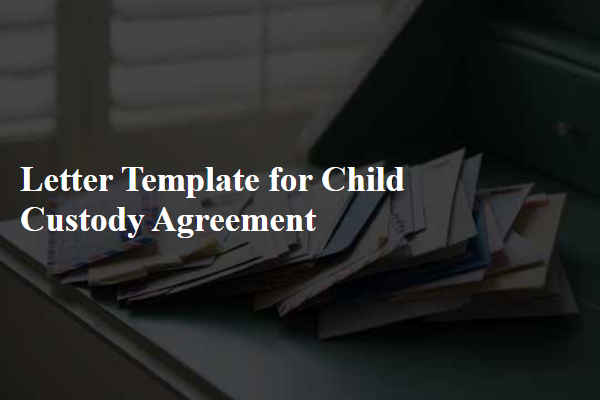Are you navigating the complexities of a child custody agreement and looking for guidance? Understanding the nuances of custody arrangements can be overwhelming, but having a solid template can make the process smoother. In this article, we'll explore a comprehensive letter template that can help you communicate your needs effectively while prioritizing your child's well-being. So, grab a cup of coffee and get ready to dive deeper into crafting your perfect custody agreement!

Clear Identification of Parties Involved
In a child custody agreement, clear identification of parties involved is crucial for legal clarity and enforceability. The primary custodial parent must be explicitly named, detailing their full name, address, and contact information, while the non-custodial parent should also be identified with similar information. It is essential to include any legal guardians or third parties involved in the child's upbringing, ensuring their names and roles are clearly defined. Additionally, it may be necessary to outline the child's full name, date of birth, and any relevant identification numbers, such as a social security number, to avoid confusion. This thorough identification establishes a foundational understanding of responsibilities and legal rights concerning child custody arrangements.
Detailed Custody Arrangement and Schedule
A detailed custody arrangement and schedule for children's welfare can include various elements such as specific days allocated for parenting time, holidays, and special occasions. For instance, a week-to-week arrangement may assign the child, family in question, to spend weekdays with one parent (Monday to Thursday), while weekends are dedicated to the other parent (Friday to Sunday). Holidays such as Thanksgiving, Christmas, and birthdays can be alternated; for example, one parent can take Thanksgiving in odd years, while the other has it in even years. A summer schedule may also specify extended time with one parent, typically allowing for a two-week period during school breaks. The arrangement should highlight the importance of maintaining open communication between parents regarding the child's needs and activities, fostering a cooperative approach for events like school performances or parent-teacher conferences. Clear provisions for transportation responsibilities and preferred drop-off and pick-up locations, such as the child's school or extracurricular venues, ensure smooth transitions between both homes. Additionally, it's crucial to establish protocols for conflict resolution, ideally through mediation or parenting classes, to prioritize the child's emotional and physical well-being throughout the custody process.
Decision-Making Authority and Responsibilities
In child custody agreements, decision-making authority and responsibilities play a crucial role in determining the involvement of each parent in their child's upbringing. This aspect outlines who has the primary authority to make significant choices related to the child's welfare, education, healthcare, and general upbringing. In many cases, parents may agree to share this authority, ensuring collaborative involvement in critical areas such as selecting schools, securing medical treatment, and making decisions regarding extracurricular activities. For example, educational decisions may require input regarding school district choices, class placements, and special education needs. Furthermore, healthcare decisions often encompass routine medical care, mental health support, and emergency decision-making protocols. Ultimately, a clear understanding of decision-making authority helps minimize conflicts and ensures stability in the child's environment, fostering a positive upbringing despite parental separation or divorce.
Provisions for Child Support and Expenses
The child custody agreement outlines essential provisions related to child support and expenses for the custodial and non-custodial parents. Monthly child support payments, typically calculated based on income, are crucial for meeting the child's needs, including housing, food, clothing, and education. Expenses related to healthcare, such as medical insurance premiums, co-pays, and out-of-pocket medical costs, should also be detailed to ensure the child's well-being. Other important costs may include extracurricular activities, transportation, and special needs services if applicable, ensuring both parents share the financial responsibilities proportionately based on their respective incomes. Specific timelines for payment and methods, such as bank transfers or checks, enhance clarity and accountability in financial support arrangements, ultimately prioritizing the child's best interests.
Dispute Resolution Mechanism
In child custody agreements, a Dispute Resolution Mechanism serves as a structured process for parents to resolve conflicts regarding custody arrangements. Mediation, often facilitated by certified mediators in family law, allows parents to negotiate in a neutral environment, aiming for amicable solutions that prioritize the child's best interests. If mediation fails, the process may involve collaborative law practices, wherein attorneys work together to reach a resolution outside of court, minimizing emotional strain on the child. Should these methods prove insufficient, binding arbitration may be employed, requiring a third-party arbitrator to make determinations that uphold the custody agreement's integrity. This thorough approach ensures disputes are handled efficiently and effectively while maintaining focus on the child's welfare and stability.













Comments